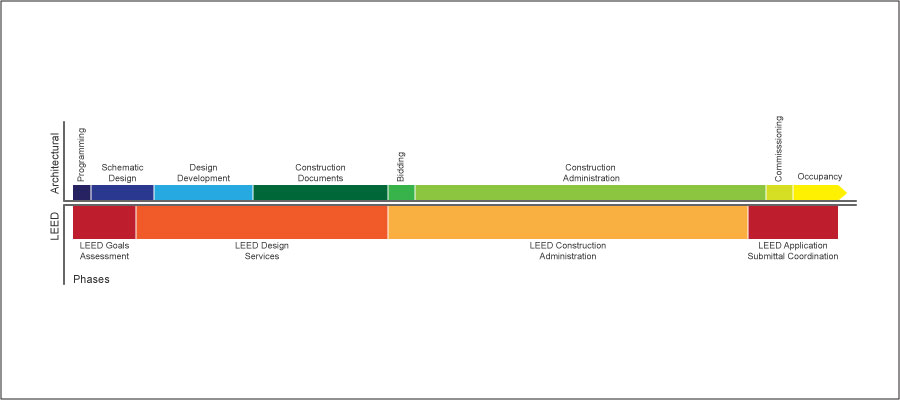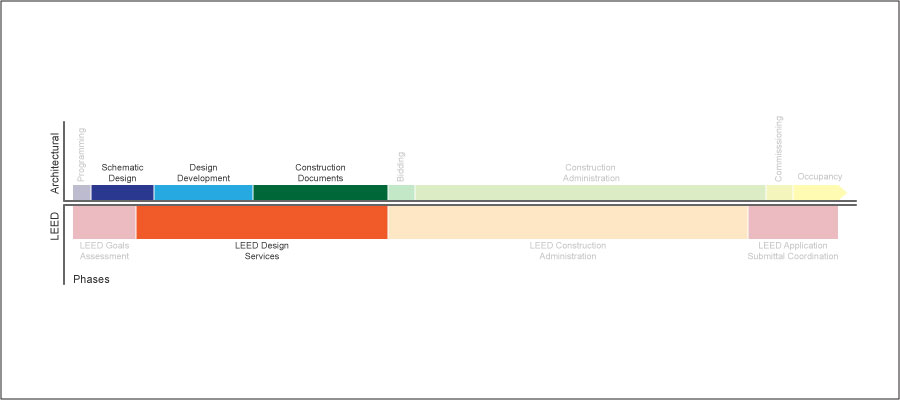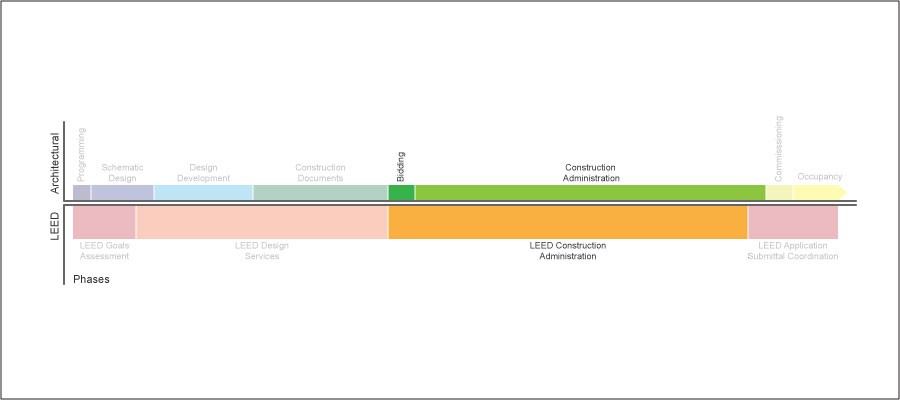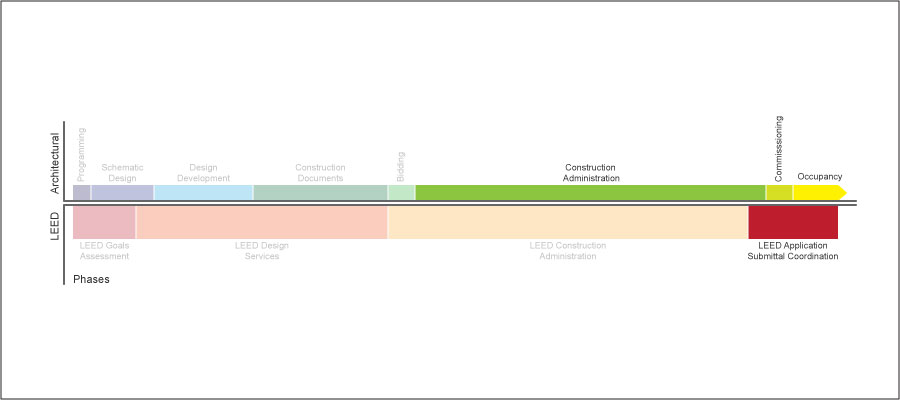




LEED (Leadership in Energy and Environmental Design)
LEED Phases do not direct correlate to the traditional architectural project phases, however, there are distinct overlaps in the planning and execution of a LEED project. As with all rating systems LEED requires large amounts of forms, proof, verification, narratives, and documents to be submitted for final review. Coordinating what is due and when is a large task that can add unwanted time and cost to the scope of a project. LEED is not just about designing and constructing green buildings. LEED is a certification process that requires a high level of communication and documentation. To ensure the success of your application, you should begin working with a LEED Consultant as early as possible in the design process. For maximum LEED credits, you should hire a LEED Accredited Professional as your LEED Consultant. You get a LEED credit right off the bat for hiring a LEED AP Consultant. Our services are divided into three general categories: Consulting and Administrative services, Design Services, and LEED Construction Administration.
Goals Assesment
LEED Goals Assessment is an early evaluation and goal setting phase where the basic goals for LEED (LEED Platinum/Gold/Silver, and major design strategies) are clearly defined along with the basic spatial layout and form of the building during the schematic design phase. Setting the LEED goals at the same time that the general form and spatial layout allows for more synergies between the design and the systems. Secondly, considering LEED from the beginning minimizes additional costs because LEED is a fundamental part of the design process, not an additional service added at the end of the architectural design process.
LEED Design Phase Services
Integration is the key to a successful sustainable project—whether attempting LEED or not. To do this, additional foresight and review is required:
- Register the project with USGBC online, establishes contact with the USGBC, and provides access to LEED-online and the CIRs
- Meet with Project Team to assign LEED responsibilities and coordinate required LEED calculations.
- Finalize the orientation of the building
- Fully incorporate LEED credits into design by:
- Review appropriateness of sustainable design strategies in relation to connection to community infrastructure, site layout, water conservation, energy efficiency, resource efficiency, and indoor environmental quality.
- Review LEED calculations for site credits to determine design parameters.
- Review LEED calculations for water-use-reduction credits to determine design parameters.
- Review LEED calculations for daylighting credits to determine design parameters.
- Select products that contribute to multiple credits.
- Research possible exterior and interior materials with multiple green attributes.
- Perform Compliance Review of materials, products, and finishes specifications / schedules sections that are often affected by LEED required elements. Provide outline of additional specifications / substitutions required to obtain LEED certification.
- Consider manufacturing processes and carbon footprints.
- Facilitate integration of green building systems into the project by:
- Working with Mechanical Engineer on HVAC and plumbing systems that meet LEED criteria. And, investigating design options for maximizing LEED Energy and Atmosphere points.
- Confering with Mechanical and Electrical Engineer for controllability of systems credits to determine design parameters.
- Confering with Electrical Engineer on electrical systems that meet LEED criteria.
- Continue to update energy model.
- Determine parameters for and documentation of LEED innovation credits.
- Finalize contract documents including specification with LEED requirements fully incorporated.
- Provide updated LEED credit assessments and scorecards regularly to evaluate number of points for desired LEED rating level.
- Complete & Submit LEED-online Design submittal- templates and additional documentation required.
LEED Construction Administration Phase
- Include LEED requirements in invitation to bid and bid requirements, and review the bid documents to confirm the LEED credits are met, as well as assist GC in reviewing bids.
- Coordinate with the contractor all LEED requirements, credits they are responsible for, anticipated submittals, applicable management plans for waste and indoor air quality, tracking of material percentages for recycled content, and tracking of construction waste.
- Attend jobsite meetings as required to answer questions, provide input and receive feedback, and ensure that LEED process stays on track.
- Review all submittals and uploads to determine compliance with LEED criteria.
- Manage and record Materials and Resources credits routinely (once a month), along with low-VOC credits from IAQ category.
- Ongoing collection of LEED construction submittals online should occur. Monitor missing information.
- Architect/ GC/ CM/ LEED-AP: Review shop drawings and project submittals paying close attention to LEED items. LEED-AP should conduct field observation visits with accompanying field reports. Document any deviations that may detract from a LEED credit.
LEED Application and Submittal Coordination
(Timing of a LEED Application Submittal(s) are based upon the timeliness and accuracy of through General-, sub-contractors’, and consultants’ requisite LEED data submittals.)
- Meet with Project Team to coordinate requirements for application submittal.
- Clarify any USGBC rulings concerning application.
- Commissioning agent to perform commissioning review.
- Perform IAQ test or flush-out building per EQ Credit 3.2.
- Collect, review, and submit final documentation.
- LEED-online Construction Submittal and verification that design credits were implemented as previously submitted.
- Handle any requests from the USGBC for additional materials.
- Accept or appeal credits (costs to appeal).
- Assist owner with paperwork to receive plaque.
- Upon certification, pursue LEED-EB if so desired.
Domain Architecture & Design 2748 Hennepin Avenue South Minneapolis MN 55408 T: 612 870 7507 F: 612 870 7507 info@domainarch.com
